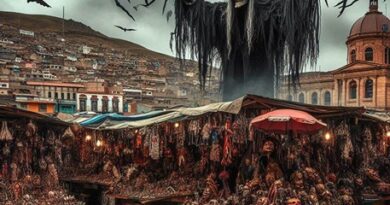Czech Republic Church of Bones: Feel Horror In Your Bones
If you come to Prague, you will surely be happy to spend at least a few days there. But even within a short driving distance, there is enough to do and do, including for the horror fans among you one of the most interesting day trips from the Czech capital is to a small town called Kutna Hora, located in the province of Bohemia (about an hour’s drive from Prague). In itself, it is a town known for centuries for its silver mines – which made it one of the richest and most important cities in the former Czech kingdom. Today Kutna Hora is a popular tourist destination, with approximately 400,000 visitors a year, with one of the main reasons being the Church Of Bones in Kutna Hora. And it’s as creepy as it sounds.
Kutna Hora, it is important to note, is a unique picturesque town with about 20,000 inhabitants. You can walk around it, admire the ancient buildings – some in the Gothic or Baroque style – and feel as if you are going back through the time tunnel. In the eyes of many tourists, and certainly horror fans, the top attraction is the Czech Republic Church Of Bones. This is the unofficial name of Sedlec Ossuary, meaning a box or some structure that was used to keep the bones of the dead in ancient times. It is a Roman Catholic chapel, located below the Church of All Saints with the Glosscam as part of what used to be the Sedlak Monastery.
Sedlec Ossuary exterior, in the Gothic style, is quite impressive from the outside although it is likely that the average European tourist has met more beautiful, prestigious, and magnificent churches. But Sedlec Ossuary outside look is not the big deal here. It’s hard not to be amazed when you go inside.

Designing With Bones
We came here to talk about bones, and it’s easy to understand why this place is called the Church of Bones. According to estimates, you will find here between 40,000 and 70,000 skeletons, skulls, and everything in between. So how exactly these bones got here? The answer is quite interesting. If in the case of the old Jewish cemetery in Prague, there were too many dead and too few spaces to bury them, here the story is both similar and different. The story begins with a monastery founded in 1142, according to findings, in the heart of a cemetery.
The cemetery Church of All Saints became in the 13th century a very sought-after burial site. The reason is the abbot’s journey to Israel, the “Holy Land”, in 1278. He returned to the Czech Republic with soil from Golgotha, the hill and rock where, according to Christian tradition, the crucifixion of Jesus occurred. He scattered it throughout the cemetery, as an act of dedication. Quickly the rumor got wings (perhaps from the carrier pigeons that were probably responsible for delivering the messages then), and people from all over Europe came to bury their loved ones in the holy place.

The interior of the Church of Bones Czech Republic. Photo: Pudelek. License: CC BY-SA 4.0
Other historical circumstances increased the scope of the problem. The cemetery simply could not store the many victims of the plagues, with an emphasis on the terrible Black Death epidemic which, according to most estimates, caused the eradication of over half of the population of Europe. If you add to this the wars that plagued the area in ancient times, such as the Hussite wars from the 15th century that claimed around 10,000 victims, you can understand why the number of bodies buried in the cemetery increased. In the 15th century, a Gothic church was built in the heart of the cemetery, whose lower chapel served as a glossary for the many graves that were uncovered during construction. In some cases, they moved the remains of bodies from the cemetery into the chapel, to make room for new bodies.
According to local legend, one of the monks of the order – who was half blind – received during the 16th century the not-so-sympathetic task of extracting the skeletons of the corpses and stacking the bones in the chapel. He did this in six pyramids, where today four pyramids remain at each end of the room. The local story has a happy ending: The monk’s sight returned to him when he completed the task.
Today the bones are scattered all over the Kutna Hora Sedlec Ossuary and organized in some creative ways. What is unique, and a little disturbing is that these bones are used here as a design item, even artistic. In some cases, the bones underwent processes of disassembly, cutting, and reassembly, which creates a unique appearance no less than the catacombs of Paris which we have already reviewed on the site.
💀 Killer Deals & Scary Recommendations 💀
🎭 Costumes & Accessories
HalloweenCostumes Fun Costumes Entertainment Earth
🛒 Online Shopping
AliExpress Amazon Walmart Etsy
🧛 Collectibles & Horror Brands
Funko Hot Topic Lego Spirit Halloween
🎢 Attractions & Tours
GetYourGuide Tiqets Viator Klook
📖 Blogs & Horror Sites
Bloody Disgusting iHorror Fangoria
🩸 Disclaimer: Some links are affiliate links. The price stays the same – it just helps keep the site alive 👻
Bones All Over The Place
The decorations and furniture of the chapel are made, as you probably guess, of bones that have undergone some disinfection and bleaching processes using lime.
The bones make up different shapes in the Church Of Bones Czech Republic, such as wreaths, trophies, flowers, coat of arms made of bones, and other surprises. They appear on the walls, on the ceiling, in the doors, in the windows, around the altar, and even on the chandelier. The chandelier is located 8 feet above the heads of the visitors, in the heart of the church, and is considered one of its hallmarks.
What is interesting about this chandelier, which hangs with wreaths of skulls, is that it has a representation of almost every human bone. The chandelier is more than a design item. It’s a memento of Mori, a symbol that reminds us of death. The goal is to convince us to remember their destiny at the end of the road and to improve their relationship with God in preparation for the death that will surely come at some point. It is clear that the chandelier has undergone quite a bit over the years, so it was necessary to disassemble, clean, and reassemble it in 2016. In general, renovations in the church are not uncommon due to the need to preserve such an ancient underground structure, which has to deal with moisture and the ravages of time.
Other interesting objects in Church Of Bones Prague (Or should we say: Near Prague) are emblems and signatures, for example, the local Schwarzenberg house: the family, which bought the property at the end of the 17th century, is responsible for financing and preparing the decorations. They hired the wood artist František Rint, who was employed by her.
Near the entrance wall, you will find the signature of the wood artist František Rint, who was employed by the family in 1870 to organize the massive piles of bones and created the unique result inspired by crypts he visited in Italy. Like any self-respecting artist, he made sure to sign his name, and he did it by organizing hand and arm bones. You will find this signature near the entrance wall of Sedlec Ossuary bone church. Totally makes sense.
How Do You Visit Czech Republic Church Of Bones?
The simplest and most recommended way to visit Kutna Hora in general, or the Church of Bones in particular, is as part of an organized tour departing from Prague. You will find different variations of this type of trip, and of course, you can choose the one that suits you best in terms of activities, schedule, and price. An average tour departs from Prague and lasts about 5-6 hours. The prices vary in each Sedlec Ossuary tour, and from our knowledge the price starts from about 30-40 euros per person and can be much higher, in the case of a private tour of Sedlec Ossuary from Prague.
Please note that the visit to the Church of Bones is not necessarily for everyone. Not sure that this is the attraction we recommend to those who come for a trip around Prague with children, of course, because the sights may scare or at least confuse some of them.
Here you can see some of the tour options in Kutna Hora and the Church of the Bones:
The Church Of Bones In Modern Culture
A gothic and creepy place like the Church of Bones in Kutna Hora must star in several cultural texts, some of them controversial. In 1970, a Czech filmmaker named Jan Švankmeier was commissioned to make a documentary about the Church of Bones, to mark the 100th anniversary of the Rink’s redesign. He produced a ten-minute film from it, called “The Ossuary”, with narration by a tour guide against a background of pictures of skeletons and bones. The authorities in the Czech Republic did not like the film, which presented scenes of death and decay that they found too subversive. They decided to change the soundtrack: Instead of the narration, they added a short introduction and a jazz version of the song “How To Make a Portrait Of a Bird” by Jacques Perver.
The Church of Bones was part of the plot of several films, documentaries or fiction, such as “Long Way Round” which describes the motorcycle journey of Ewan McGregor and a British host/actor named Charlie Borman from London to New York. It is one of the locations in the “Dungeons and Dragons” film series from the 2000s, is depicted in several films (for example, “Adaptation” by Spike Jonze), appears on the album cover of a Swedish metal band called Diabolical Masquerade and even in the second season of “The Amazing Race” in Israel, in which one of the contestants had to count the number of skulls in the main hall (936, for those interested) while his partner read aloud about the history of the church to distract him. It is said that the Bone Church influenced the design of Dr. Satan’s Lair in Rob Zombie’s “House of 1,000 Corpses”.







